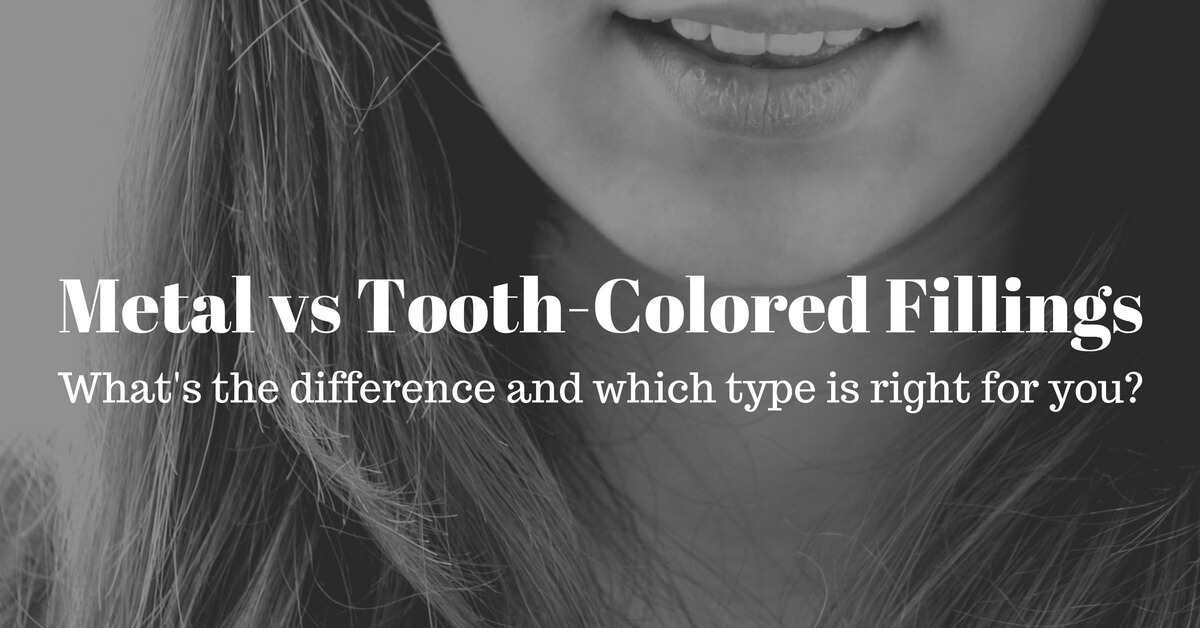What's the Difference between Metal and Tooth-Colored Fillings?
Are your fillings metal or do they match the color of your teeth? People often ask me about the difference between metal and tooth-colored fillings. It’s a good question.
When dentists fill a cavity, they first remove the decay, thoroughly clean the area, and fill the cavity with a filling material. A good filling will last anywhere from 5 to 50 years. If you’re going to have a filling in your mouth for that long, it’s fair enough to want to know what it’s made of and how it compares to other types of fillings.
The two most common filling materials dentists use are silver amalgam fillings and tooth-colored composite fillings. Let’s look at the pros and cons of each filling type and why dentists sometimes choose one over the other.
Silver Amalgam Fillings
If you have a metal filling in your mouth, chances are it’s a silver amalgam filling. Silver amalgam fillings last a long time, but they require your dentist to remove more tooth structure.
Silver amalgam fillings last a long time.
Silver fillings are sturdy. They are a tried-and-true option that last a long time in most patients. You just can't beat their longevity!
Silver amalgam can be easier to place.
The material is very forgiving in environments where other fillings could not be placed successfully. For example, most filling materials need a dry environment to be effectively bonded to your tooth, but amalgams can be placed even if your tooth is wet.
Amalgam fillings mean more tooth gets removed.
Your dentist has to remove more tooth structure ensure a long-lasting filling. Most dentists will tell you that removing less natural tooth structure is generally better when possible.
Amalgam fillings aren’t like your natural teeth.
Amalgam fillings expand and contract differently than the tooth itself, so we sometimes see cracks in the natural tooth around a silver filling as a result of this difference in expansion and contraction. This can eventually lead to decay forming in the cracks, tooth sensitivity, or tooth breakage.
That’s just one reason why it’s important to see your dentist regularly so he or she can check out your fillings.
Should You Be Worried about Mercury in Metal Fillings?
Many people worry about the small amount of mercury in silver amalgam fillings.
When it comes to your health, the American Dental Association (ADA) says there’s no need to worry. Most of the mercury rises to the surface of the filling when it is placed, and it is scraped away during the placement and shaping process. There is a small amount of mercury that remains in the filling, and when a silver filling is removed, it is basically pulverized by the dental drill and becomes dust.
The ADA still stands by research that supports that silver fillings are safe. Most of the reason silver fillings are considered "unsafe" or are no longer used in some countries is because of the impact the mercury could have on the environment after it leaves the dental office waste system and enters the public water waste system.
Tooth-Colored Composite Fillings
These days, more and more patients are getting tooth-colored fillings. They look more natural and don’t require your dentist to remove as much tooth structure. Here’s what you should know:
Composite fillings can save more tooth structure.
Tooth-colored composite fillings are great because they look natural and they bond directly to the tooth so dentists do not need to remove much tooth structure to place them. Composite fillings also don’t put you at risk for cracks in adjacent natural tooth structure the way amalgams do.
Composite fillings are repairable.
If there’s a problem with a small area of a composite filling, we can remove and replace just that part without replacing the entire filling. If there’s a problem with even a small part of your amalgam filling, we’d have to remove the whole thing.
Composite fillings have to be placed in a dry tooth.
As you can imagine, this can be a challenge in a wet mouth environment! In some cases, we simply can't get a tooth as dry as we need to for composite. Then, a silver filling may be a better option.
Composite fillings are more complicated.
Filling a cavity with composite material requires many more steps and products. It’s also much more technique sensitive. In some cases, getting a tooth-colored filling means more time in the dentist’s chair.
Composite fillings haven’t been around as long.
More and more dentists (and more and more patients!) now prefer composite fillings when possible, but they’re still a relatively new development compared to silver fillings. They don't have quite the same track record of longevity as amalgams do, but the materials are getting better and stronger, and many dentists these days would probably argue they can last as long as amalgams.
Which Material is Right for You?
If you need a cavity filled, your dentist can talk to you about your options, answer your questions, and help you decide which is right for you.
If you think you may have a cavity, the best thing you can do is see your dentist early before the decay gets worse. The earlier you catch cavities, the more options you have!
I’d love to answer your questions about fillings and help you understand which material is the right choice for you. Just call (540) 298-6696 to schedule an appointment.




